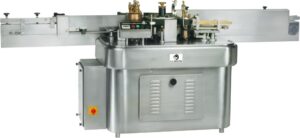
Introduction to Wet Glue Labelling
Cold glue labeling, also called wet glue labeling, is a conventional way used in the packaging industry. Sticky labels are applied with wet adhesives rather than self-adhesive or pressure-sensitive ones with pre-applied adhesive. Such a technique has been in operation for several years and has changed over time to meet the demands of modern packaging.
Evolution of Wet Glue Labeling Technology
The beginning of wet glue labeling can be traced back to the early 20th century when products were being labeled manually. Technology advancement has seen to it that semi-automated and automatic machines replaced manual labeling which was faster and more precise.
First wet glue labeling machines were simple equipment comprising a label dispenser, a mechanism that placed labels on products with adhesive, and a glue applicator. These machines demanded much input from their operators due to their inconsistent nature.
However, technological advancements have transformed wet glue labeling machines completely. The latest models have come with advanced technologies where users are offered accurate control over speed, placement of labels as well as how the glue is applied. This means such machines can handle different packaging requirements as they can accommodate different label materials shapes and sizes.
Working Principle of Wet Glue Labeling Machine
How does this work? Here’s an overview, step by step of how these pieces of machinery function;
Label Feeding: Labels are fed into the labeling head after mounting a label roll onto the machine.
Glue Application: The roller or wheel applies a sticky substance at the back side of these labels. A water-based adhesive is typical which was specially designed for bonding between diverse substrates.
Label Application: The conveyor belt moves labeled items along and specifically assigns certain areas of products for applying pasted-up labels through this labeling head.
Pressure and Cure: Pressure is applied after affixation so that proper adhesion between the product surface and the label takes place. Some of such machines come with curing stations to speed up the drying process.
Quality Control: Sensors and vision systems are found in the most recent wet glue labeling machines which check labels for misalignment, defects, and precision. The difference is detected right away even if any other mistake is made so that a proper label can be placed.
Packaging Integration: In many production lines, wet glue labeling machines are integrated seamlessly with other packaging machinery such as fillers, cappers, and sealers, creating a streamlined packaging process.
Advantages of Wet Glue Labeling
Wet gluing offers several benefits over alternative labeling methods thus it’s better suited for various manufacturers;
Cost-Effectiveness: This type of label is usually cheaper than self-adhesive ones especially when making huge volumes at once. For instance, the adhesive used in these labels is typically less expensive when compared to the pressure-sensitive adhesives utilized on self-adhesives.
Versatility: Different sorts of materials including paper, plastic as well as foil can be employed by wet glue labeling machines for a broad range of shapes and sizes. These attributes make them appropriate for different industrial packaging uses.
High-Speed Operation: Furthermore, they have a quickness that saves time since modern wet glue labeling machines can work at high speeds thereby enhancing efficiency in production lines.
Environmentally Friendly: Still on this note, water-based adhesives employed herein are more eco-friendly than solvent-based ones often seen on self-adhesive labels. Moreover, due to their unavailability of non-recyclable components such as release liners present in self-adhesive labels recycling wet glue labels is simple.
Exquisite Look: Wet glue labels have exquisiteness in the outlook, especially for high-end products. Those labels stick seamlessly on the product surface to yield a quality and professional look.
Applications of Wet Glue Labeling
Wet glue labeling is applied in different industries such as:
Food and Beverage: The food and beverage industry extensively uses wet glue labeling for bottles, jars, cans, and other packaging types. It is suitable for glass or plastic containers often used to package sauces, condiments drinks, and many more.
Personal Care and Cosmetics: In personal care and cosmetics, wet glue labeling is commonly employed in marking bottles, tubes, or containers holding skin care products, shampoos, and lotions among others. It sticks well on various packaging materials thereby enhancing the attractiveness of products.
Pharmaceuticals: Medicine bottles together with vials are labeled using sticky paper in the pharmaceutical industry. This ensures that reliable information gets relayed to clients while at the same time following legal requirements related to affixing these tags.
Chemicals and Household Products: Even chemicals need wet glue labeling if they are going to be sold because it serves as a great way of identifying them from other unmarked bottles or drums of industrial goods meant for cleaning homes.
Future Trends and Innovations
While the technology behind wet glue labeling has become highly sophisticated there is still further improvement through continuous innovation. Some emerging trends and innovations in wet glue labeling include:
Digitalization and Automation: Wet glue labeling machines should be integrated into digital systems besides being automated resulting in real-time monitoring data analytics during remote control over label ennobling processes improving efficiency as well as productivity.
Advanced Adhesives: With the development of environmentally friendly adhesives that are high performance; their superiority lies in higher bonding strength than ordinary ones plus faster curing times ensuring compatibility with a wide range of substrates
Precision Labeling: Through advancements made on devices for greater precision labeling heads plus control systems, in particular for complex shapes or contours.
Augmented Reality Labels: Wet glue labels become more interactive and immersive to the consumer by incorporating augmented reality (AR) technologies which offer new experiences such as product information games and promotions.
Sustainability Initiatives: Recycling materials used in wet glue labeling, reducing waste, and energy-saving manufacturing processes should be considered sustainable practices.
